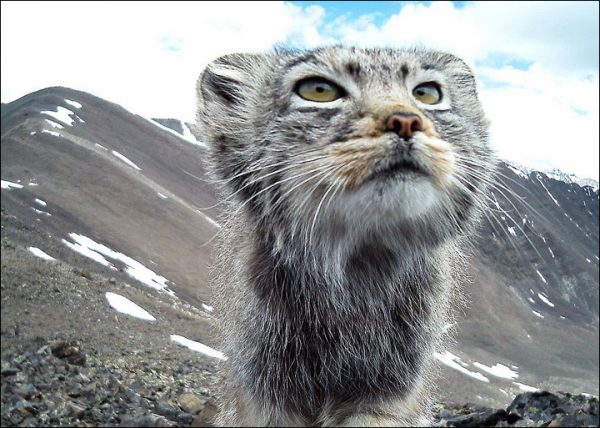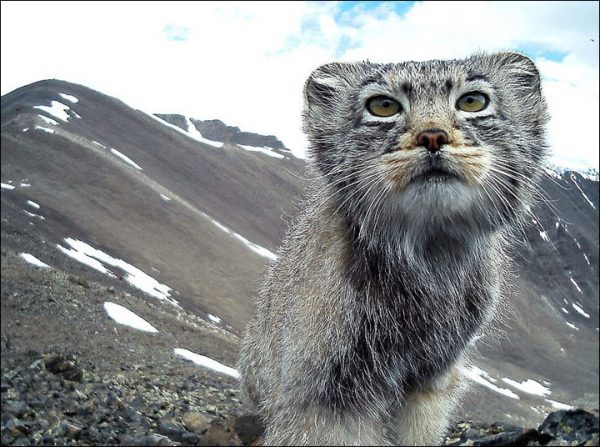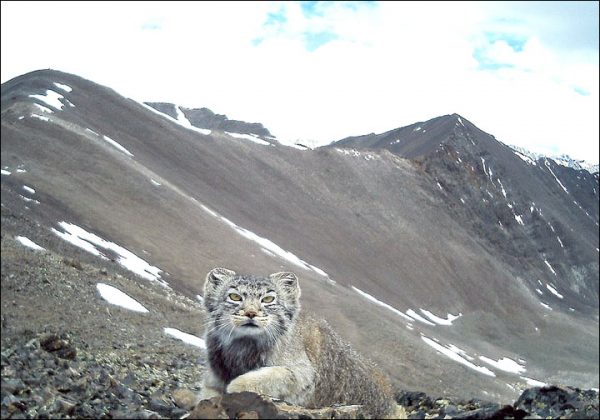
One of the World’s Most Secretive Cats
The secretive Pallas’s Cats can be found primarily in the grassland and shrub-land steppe of Central Asia, but is found as far west as Western Iran and previously was known to inhabit Armenia and Azerbaijan. The core populations of Pallas’s Cat exist in Mongolia and China where they can live in elevation of 5,050 meters on the Tibetan Plateau.

This secretive cat is rarely seen so getting an estimate on population is difficult. With the addition of camera traps, images of the fluffy cat with the expressive face are popping up more frequently. Also known as Manul cats, a name of Mongolian origin this wild cat is about the same size as our domestic cats, even though they appear much bigger. The cat has an amazing 9,000 hairs per square centimeter and the hair can be up to 7 centimeters in length, making their fur longer and denser than any other cat!

The reclusive behavior and rarity of the species has prevented a specific conservation action being implemented to protect resources essential for the cats’ survival. The threats to Pallas’s Cat are habitat degradation and fragmentation. The degradation is occurring due to increased human population and the expansion of animal husbandry across the species range. Over-hunting and poisoning of the Pallas’s Cat prey base is another serious threat.
what do pallas’s cats eat?
Daurian pikas are the most frequent prey for Pallas’s cats. These cats also eat a range of small mammals, insects, birds, reptiles and carrion.
Pallas’s Cats are Listed as Near Threatened under CITES
Listed as Near Threatened under CITES, hunting of Pallas’s Cat is prohibited in all range countries except Mongolia where the cat has no legal protection even though classified as Near Threatened in the country. The Pallas’s Cat has long been hunted for their fur in relatively large number in Mongolia, Russia and China but international trade in Pallas’s Cat pelts has nearly stopped since the late 1980s. Last estimate, there were 1000 hunters of Pallas’s Cats in Mongolia with an estimated mean harvest of two cats per year. Pallas’s Cats are also shot by mistake by hunters looking for marmots. The cats are trapped as by-catch in leg-hold traps set for wolves and foxes and in snares set for marmot and hares.

The cat is a distant relative, millions of years ago, to the leopard. The cat is a native of Siberia but lives in the shadow if their more famous cousins the Amur Tiger and Leopard. Technology will help scientists learn more about this gorgeous little cat, by capturing them on camera like the photos in this post captured by camera trap in the Altai Biosphere Reserve.
FREQUENTLY ASKED QUESTIONS
What is the lifespan of Pallas’s Cats in Captivity?
Pallas’s Cats, also known as manuls, thrive in utilizing burrows for a variety of purposes, including finding shelter, protecting themselves from predators, giving birth, and nurturing their young. When kept in captivity, these feline creatures have displayed the capability to live up to 12 years of age.
How Large are the Home Ranges of Pallas’s Cats?
Pallas’s Cats are known to have exceptionally large home ranges despite their small size. Both males and females maintain separate territories, with males having overlapping territories with multiple females. Female territories in Mongolia were found to range from 7.4 to 125 square kilometers, with an average of 23 square kilometers. On the other hand, male ranges were observed to span from 21 to 207 square kilometers, with an average of 98 square kilometers. These home range sizes indicate that Pallas’s Cats require vast areas for their activities and resource utilization. Limited studies on population density have suggested an estimated range of 4 to 8 individuals per 100 square kilometers, providing some insight into the density of these elusive felids.
How do Pallas’s Cats Reproduce?
Pallas’s Cats, also known as Manuls, have a unique reproductive cycle that is highly seasonal. Mating typically occurs during the months of December to March, while the kittens are born later from March to May. Interestingly, the female’s period of fertility, known as oestrous, lasts for a relatively short duration of only 24-48 hours.
In captivity, the gestation period for Manuls has been recorded to range between 66 and 75 days. Female Manuls give birth to their kittens during late April and May in Siberia. On average, the litter size can range from one to six kittens, with three or four being the typical number.
When born, Pallas’s Cat kittens have a dark and woolly coat, distinct from the older cats’ frosted appearance. Their sides display more noticeable striping, which tends to fade as they grow older. Around two months of age, the kittens go through a molting process, shedding their juvenile coat. At this stage, they weigh between 500 and 600 grams.
Pallas’s Cats become independent at around 4 to 5 months of age and reach their adult size and weight around eight months. Sexual maturity is typically achieved at 9 to 10 months. In captivity, Pallas’s Cats have been observed to live up to 12 years of age.
Overall, the reproduction and growth of Pallas’s Cats involve a clear seasonal breeding pattern, a relatively short period of fertility for females, the birth of a moderate-sized litter, and a gradual transition to adulthood.
Beautiful cat. Thanks for sharing about them.
Sue B
this is such a thrilling post. To see the cats in pictures. I hate that people are threatening them Grrrr
dood…ewe R total lee awesum !! yur furz ree mind uz oh de siberian
lynx !!!
we R troo lee sorree bout yur habitat N az sorree two lurn bout those hunterz ~~~~~ ???
We love the Pallas cats and have wanted to learn more about them.
I love Pallas Cats! Thanks for sharing these photos.
All kitties are so very beautiful and precious. Id love to spoil her withchicken, fish and everything she likes.